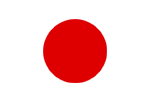Color of the Sky
This theme is related to the wavelength of light. When light collides with molecules in the air such as oxygen, nitrogen,water vapor, and particles smaller than the wavelength of light, the short-wavelength light is strongly scattered. So, the daytime color of the sky looks blue.The evening is slightly different.
During the day,at a slant incident light comes from directly above, but light enters in the evening. The light must pass through longer distances, and much short-wavelength light such as blue light is scattered. Long wavelengths such as red and yellow light reach the ground. So, the sky looks red in the evening.
◎ 【Video:Reproducing the sky with an experimental apparatus】
①Put water in a cylindrical glass case.Drippng a little milk in it.
②Place a light underneath,and see the state of the light.
③Near the light source, the blue light that is shorter wavelengths is scattered. Therefore, it looks like the blue sky. Far from the light source, the light orange or yellow light that is longer wavelengths is scattered. Therefore, it looks like the sunset.

